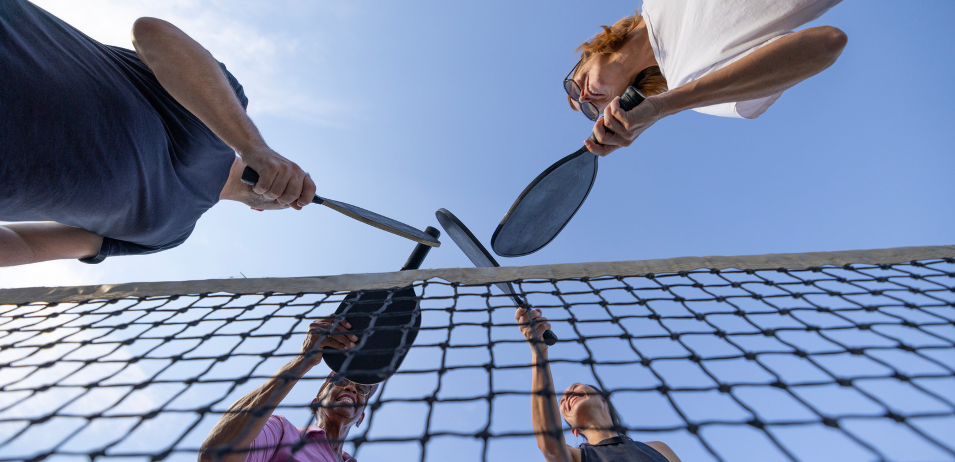-
Sounds cool! How do I play?
Let's face it – reading rulebooks is about as exciting as watching paint dry. But if you want to play pickleball without getting the side-eye from those seasoned players in matching outfits, you'll need to know the basics. Don't worry, though – I'm here to break down the rules in a way that won't put you to sleep.
Serving Rules: The Gateway to Glory
First things first: the serve. This is where every point begins, and boy, do pickleballers love their serving rules. Here's what you need to know:
The serve MUST be done underhand. None of that fancy overhead tennis serve business here. Your paddle must make contact with the ball below your waist, and preferably before your opponent falls asleep waiting.
Both feet must stay behind the baseline until you hit the ball. No running starts allowed – this isn't the Olympic long jump.
Serves must go diagonally across the court, landing in your opponent's service box. Hit it straight ahead, and you'll quickly learn what "fault" means (spoiler: it's not good).
Only one serve attempt is allowed. Unlike tennis, there's no second serve to save you. Make it count!
The serving team must announce the score before each serve. It goes like this: serving team's score, receiving team's score, and the server number (1 or 2). Example: "4-2-1" means serving team has 4 points, receiving team has 2 points, and it's the first server's turn.
The Two-Bounce Rule: A Pickleball Tradition
After the serve, we enter the realm of the famous "two-bounce rule" (also called the double-bounce rule). Here's how it works:
The serving team hits the serve…
The receiving team must let it bounce before hitting it back…
The serving team must then let that return bounce before hitting it…
After these two bounces, all hell breaks loose – you can volley (hit the ball before it bounces) to your heart's content. Unless, of course, you're in...
The Kitchen: No Snacking Allowed
Ah, the kitchen – officially known as the "non-volley zone" but nobody calls it that except rulebook writers. This is the 7-foot zone on each side of the net where volleying is strictly forbidden. Here are the kitchen rules:
You can't volley the ball while standing in the kitchen or even touching the kitchen line. Not even a toe can be in there.
If your momentum carries you into the kitchen after a volley, that's a fault. Physics majors, take note: your forward motion needs to stop before entering the sacred space.
You CAN stand in the kitchen all day long if you're hitting balls that have bounced. Just remember that standing there makes you look like a newbie.
If you drop the ball in the kitchen and try to hit it without letting it bounce, that's a fault. Yes, even if you're trying to be clever.
Scoring: Points, Games, and Matches
Scoring in pickleball is straightforward, with a few quirks:
Games go to 11 points, and you must win by 2. Yes, this means games can go on forever if teams keep trading points at 10-10.
You can ONLY score points when your team is serving. When receiving, you're just trying to win the serve back.
In doubles, each player on the serving team gets a chance to serve before the serve goes to the other team (unless it's the start of the game – then only one player serves first).
Faults: Ways to Lose Points
There are more ways to commit faults in pickleball than there are flavors at an ice cream shop. Here are the greatest hits:
- Hitting the ball into the net
- Hitting the ball out of bounds
- Volleying from the kitchen (or touching the kitchen while volleying)
- Breaking any of the serving rules
- Letting the ball bounce twice on your side
- Touching the net while the ball is in play
- Hitting the ball before it crosses the net to your side
Line Calls: The Source of All Drama
In casual play, players make their own line calls, and here's where things can get spicy:
If the ball lands on the line, it's IN. Even if it just barely kisses the line, it's still in.
You should only call balls out on your side of the court. Leave your opponent's side to them.
If you're not 100% sure the ball was out, call it in. This is the "when in doubt, it's in" rule.
The Spirit of the Game
While not officially in the rulebook, there are some unwritten rules that good pickleballers follow:
- Call your own faults. If you know you touched the kitchen line during a volley, call it on yourself.
- Don't be a line call bully. Nobody likes playing with someone who argues about every close call.
- Apologize for "lucky" shots that nick the net and dribble over. We call these "lets" in tennis, but in pickleball, they're fair game – just be gracious about it.
The Most Important Rule
Have fun! Seriously, pickleball was invented as a backyard game to entertain bored kids. While the rules might seem complicated at first, they're designed to make the game enjoyable and fair for everyone.
Remember, every pickleball pro was once a beginner who didn't know a kitchen from a non-volley zone. Take your time learning the rules, and don't be afraid to ask questions. Most players are happy to help – as long as you're not interrupting their serve!

